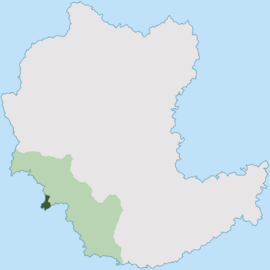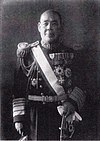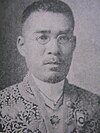Hoterallian Occupation of Freice: Difference between revisions
m (→List) |
(→List) |
||
| Line 211: | Line 211: | ||
|- | |- | ||
| 2 | | 2 | ||
| [[File: | | [[File:Tala Aimea.png|100px]] | ||
| '''Tala Aimea'''<br />{{small|(1882–1961)}} | | '''Tala Aimea'''<br />{{small|(1882–1961)}} | ||
| 12 November 1915 | | 12 November 1915 | ||
Revision as of 16:18, 17 April 2022
This article is incomplete because it is pending further input from participants, or it is a work-in-progress by one author. Please comment on this article's talk page to share your input, comments and questions. Note: To contribute to this article, you may need to seek help from the author(s) of this page. |
Hoterallian Mandate for the Governance of the Freice Island
| |||||||||
|---|---|---|---|---|---|---|---|---|---|
| 1911–1931 | |||||||||
 The division of Freician authority in 1921
| |||||||||
| Status | Territory of the Empire of Hoterallia (1911-1920) Mandate of the Empire of Hoterallia (1920-1931) | ||||||||
| Capital | Sekapa (せかぱ) | ||||||||
| Common languages | Hoterallian (official) Freician | ||||||||
| Director of The Supreme Authority | |||||||||
• 1911–1915 (first) | Satō Tetsutarō | ||||||||
• 1929–1931 (last) | Kakuji Kakuta | ||||||||
| Governor of The Elected Authority | |||||||||
• 1913–1915 (first) | Tamalei Sava | ||||||||
• 1929–1931 (last) | Penara Kamitua | ||||||||
| Historical era | Empire of Hoterallia | ||||||||
• End of the Great War | 11 November 1911 | ||||||||
• Handover ownership back to Riamo | 18 July 1931 | ||||||||
| Currency | Hoterian, Hoterallian-issued Freician currency | ||||||||
| |||||||||
| Today part of | Freice | ||||||||
The island of Freice became a mandate of Hoterallia in 1911. Officially the Hoterallian Mandate for the Governance of the Freice Island, was a mandate in the Kaldaz Ocean given to the Empire of Hoterallia by Riamo following the Great War.[1] The mandate consisted of the island of Freice until they were occupied by Hoterallia during the Great War. Hoterallia governed the island under the mandate as part of the Hoterallian colonial empire until the official handover back to Riamo. The island is now the Country of Freice[2][3]
In Hoterallia, the territory is known as "Hoterajia Governance of Namimin" (ほてらじあ委任統治領並外民群島, Hoterajia Inin Tōchi-ryō Namimin Guntō) and was governed by the Sekapa Government (せかぱ廳, Seka-pa Chō).[1]
Administration

Following the initial Hoterallian occupation of the islands, a policy of secrecy was adopted. Hoterallia made it plain that it want to turn the island of Freice into a naval base for the Imperial Hoterallian Navy to sustain a presence in the Kaldaz Ocean. During the first two years that Hoterallia occupied the islands, it consolidated its presence and the island became a virtual Hoterallian colony. The IHN divided the territory into five districts: Sekapa-Ku (せかぱ区), Peka-Ku (ぺか区), Koimuke-Ku (こいむけ区), Dakorane-Ku (だこらね区) and Marana-Ku (まらな区), with all reporting to a rear admiral at the naval headquarters at Sekapa-Ku.[4]
As promised by Hoterallia, the Imperial Hoterallian Navy does not seize full control of the entire island but a small port in Sekapa-Ku. Hoterallia was able to continue administering the island under the Supreme Authority as if they were colonial possessions, keeping their waters off-limits to foreigners. After establishing its heavy presence on the island, Hoterallia directs full control over the island's domestic legal system. Hoterallia administered them as Hoterallian territory and as part of the Hoterallian Empire.[2]
Militarily and economically, Sekapa was the most important district in the mandate and became the center of subsequent Hoterallian settlement. Other towns and regions were developed to resemble small towns in Hoterallia, with cinemas, restaurants, beauty parlors, and ochaya (tea houses).[5] Port of Sekapa was fortified into a major navy base by the IHN.
Between 1912 and 1913 the islands began the slow transition from naval to civilian administration. By 1913 all authority had been transferred from the Naval Defense Force to the newly established Freician Elected Authority which was directly responsible to the Navy Ministry. Complying with the peace treaty with Riamo, the IHN did not expand its presence throughout the entire island but retained its power in the Port of Sekapa and exercise its power through The Hoterallian Naval Authority.[6] In August 1913 a civilian government was established in each of the five administrative districts (Sekapa-Ku, Peka-Ku, Koimuke-Ku, Dakorane-Ku, and Marana-Ku) in the form of a civil administration department that still reported to the local naval garrison commander and the Hoterallian Supreme Authority. At the same time, the post of Governor of The Elected Authority was created. Governors were mostly elected by the Freician population and appointed by the Hoterallian Supreme Authority. The Governor reported to the Director of The Supreme Authority. The establishment of the "Governor of The Elected Authority" or "Seka-pa Chō" in March 1920 finally put the government of the islands under a purely civilian administration.[7]
Hoterallian Supreme Authority
The Hoterallian Supreme Authority (ほてらじあ最高権威, Hoterajia saikō ken'i) was the head body of the governance during the occupation, the head of the Authority was the Director of The Supreme Authority (最高権威局長, Saikō ken'i kyokuchō). The body was established shortly after the invasion of Freice by the IHN as the replacement for the previous Riamese position. The Authority's job was to administer the island and its internal issues, the job was later handover to the Freician Elected Authority.
List
The following is a list of the Directors of The Supreme Authority, as well as their predecessors during the Hoterallian occupation of the territory between 1911 and 1913.
| No. | Portrait | Name (Birth–Death) |
Term of office | ||
|---|---|---|---|---|---|
| Took office | Left office | Time in office | |||
| ほてらじあ本帝国海軍支配 (Hoteraji a hon teikoku kaigun shihai) ( | |||||
| Military Governor | |||||
| 1 | 
|
Ryōta Nagase (1881–1943) |
28 July 1910 | 18 August 1911 | 1 year, 21 days |
| 2 | 
|
Takashi Gokita (1870–1948) |
18 August 1911 | 20 December 1911 | 124 days |
| 3 | 
|
Takuya Katayanagi (1867–1934) |
20 December 1911 | 12 March 1912 | 5 years, 82 days |
| 並外民島局長 (Namimin shima kyokuchō) (Director of The Island of Freice) | |||||
| 4 | 
|
Satō Tetsutarō (1869–1934) |
3 January 1911 | 15 May 1913 | 2 years, 132 days |
| 最高権威局長 (Saikō ken'i kyokuchō) (Director of The Supreme Authority) | |||||
| (4) | 
|
Satō Tetsutarō (1869–1934) |
15 May 1913 | 21 April 1915 | 1 year, 341 days |
| 5 | 
|
Masaru Kagiwada (1871–1942) |
21 April 1915 | 2 July 1916 | 1 year, 72 days |
| 6 | 
|
Kōichi Masuzaki (1869–1941) |
2 July 1916 | 11 October 1919 | 3 years, 101 days |
| 7 | 
|
Masahiko Yū (1867–1934) |
11 October 1919 | 29 September 1922 | 2 years, 353 days |
| 8 | 
|
Kōichi Makida (1867–1934) |
29 September 1922 | 4 January 1925 | 2 years, 97 days |
| 9 | 
|
Taku Kanegae (1880–1951) |
4 January 1925 | 19 June 1926 | 1 year, 166 days |
| 10 | 
|
Yūki Ita (1883–1949) years |
19 June 1926 | 11 November 1927 | 1 year, 145 days |
| 11 | 
|
Naomi Yamanoi (1889–1967) |
11 November 1927 | 19 August 1929 | 1 year, 281 days |
| 12 | 
|
Tarō Yazawa (1898–1967) |
19 August 1929 | 18 July 1931 | 1 year, 333 days |
Freician Elected Authority
The Freician Elected Authority (並外民選出された権威, Namimin senshutsu sa reta ken'i) was an elective body created in response to the self-management of the civilian occupation in Freice. The Empire of Hoterallia was unwilling to put up troops against the native population in Freice as it was against the Hoterallian tradition of preserving culture and history. The post was established in 1913 and most of the candidates were native Freicians. The Freician Elected Authority was responsible for the island's internal issues and helped the Hoterallian Naval Authority establish a presence of a civil occupation. The head of the Authority was the Governor of The Elected Authority (選出された当局知事, Senshutsu sa reta tōkyoku chiji), who report directly to the Hoterallian Supreme Authority. The governors were the very few first signs of self-governing in Freice, even though the governors were supposed to be appointed by the Director of Supreme Authority and exercise less power, they still heavily influence Freician's road to self-government.
List
The following is a list of the Governors of The Elected Authority.
Significance
The population of the mandate was too small to provide significant markets and the indigenous people had very limited financial resources for the purchase of imported goods. The major significance of the territory to the Empire of Hoterallia was its strategic location, which was strategically positioned and provided convenient provisioning locations for sailing vessels in need of water, fresh fruit, vegetables, and meat.[8]
As a requirement from the treaty signed with Riamo, Hoterallia agreed not to build new naval and air stations on the islands. Nevertheless, the territory provided important coaling stations for steam-powered vessels.[9]
Economy
The island was modernized, with Hoterallia investing upwards of 10 million ACU. The impoverished areas like Sekapa were laid out with wide streets, solid housing areas, government buildings, electrification throughout, a sewer system, and a safe drinking water supply.[10] Schools were built and student enrollment skyrocketed, the Hoterallian sent several Gaoist missionaries to the island to encourage Gaoism to the natives but was ineffective.[11] Hoterallian educational curricula were put into place, and some of the subjects were modified to fit the environment, this includes the reintroduction of the Freician language in schools.[12]
With the expansion of economic activity and public works, Hoterallian banks opened one branch office in Sekapa, the Jia-Nanimin Bank. Transportation around the island was improved to accommodate the growing and modernizing island.[13]
The Riamese Empire had started producing currency locally for all colonial holdings by the turn of the 20th Century, so when Hoterallian forces captured the island, it didn't take long for the banknotes and coins to be made useless in the wider overseas Riamese market. As a response to the situation, The Supreme Authority had pre-printed a large amount of what would become the Hoterallian-issued Freician currency. This currency was then introduced on the island via a temporary transitional period of fixed exchange rates (provided by the Authority) between the hoterians and the now useless pre-invasional currency, which was recorded to continue in usage locally for at least a year after the transitional period was over. The initial exchange rate offered by The Supreme Authority was set at XXXX:1, which would remain very stable during the transitional period and afterward, mainly, due to the low population of the islands and the consequently low amount of exchanged currency.[14]
| Image | Value | Obverse | Reverse | Watermark |
|---|---|---|---|---|
| [1] | 1c | Palm-lined beach | Headquarters of the Supreme Authority | Imperial Seal of Hoterallia |
| [2] | 5c | Palm-lined beach | Port of Sekapa | Imperial Seal of Hoterallia |
| [3] | 10c | Sugarcane field | Man and water buffaloes in a stream | Seal of The Supreme Authority of Hoterallia |
| [4] | 50c | Banana tree, guava tree, and coconut palm | Beach facing the sea with a Hoterallian ship on the horizon | Seal of The Supreme Authority of Hoterallia |
| [5] | ₵1 | Emperor Norihi | Man on a boat using a fishing net | Seal of The Supreme Authority of Hoterallia |
| [6] | ₵5 | Emperor Norihi | Sailors of the Imperial Hoterallian Navy | Seal of The Supreme Authority of Hoterallia |
| [7] | ₵10 | Emperor Norihi | Kaihō-sha Shrine | Seal of The Supreme Authority of Hoterallia |
Shortly before the handover back to Riamo, the Supreme Authority advised the whole mandate to exchange the issued currency into the Riamese hull or the Hoterallian hoterian in case of the new government decided to ban the issued currency.
References
- ↑ 1.0 1.1 Kanna, Kobayashi (2018) "A Study On The Land of The Southern Phoenix And Its Previous Footings."
- ↑ 2.0 2.1 "Hoterallia And Freice: An Island Where The Phoenix Once Landed." Minami no Taiyō. Retrieved December 11, 2018.
- ↑ "History". Freice Assembly of Delegates. Retrieved 12 January 2019
- ↑ Iqē, Pēgā, A. (2007). The National Encyclopedia of Freician History and Culture (2nd ed.). Guri: University of Guri Press. p.145. ISBN 918-0-28319-399-2.
- ↑ "Freice And Its History of Being 'Little Hoterallia'." Orajioe Daily. Retrieved September 9, 2012.
- ↑ "The History of The Imperial Hoterallian Navy: Freician's Naval Authority" Hojo Daily. Retrieved October 10, 2007.
- ↑ Marcos, Julia F. (2013) Liberation: The History of the People who Fought for Freedom. Santa Elisa: Pueblos, p.92. ISBN 991-2-34776-732-5
- ↑ Taku, Akagi; Satoru; Yoshizuka (1976) "Why Freice Was A Strategic Location For The Hoterallian Navy." Guri: University of Guri Press.
- ↑ Takuya, Katayanagi (1913) "The Affairs In Namimin." Government of Hoterallia.
- ↑ Masato, Dodo (1914) "The Plan To Modernize A Little Island." Hojo Daily. Retrieved July 24, 2012.
- ↑ "Gaoism In Freice." Island Government of Freice. Retrieved September 19, 2009.
- ↑ "History of Freician (Common)". Kaunio Landua oe tela Lieo Faio. Retrieved February 19, 2019.
- ↑ Wataru, Kawahata (1925) {並外民島発展に関する報告。} (In Hoterallian)
- ↑ "Hoterallian Occupation Currency." Freician Occupation Memorial. Retrieved January 17, 2015.





